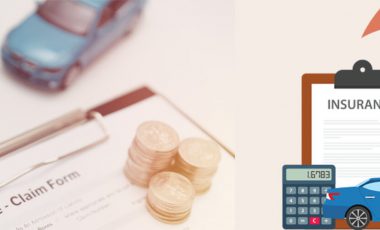Auto Insurance Terminology Guide
Certain auto insurance terms are not very common and a bit complex to understand. While buying auto insurance, the company asks for a different kind of information and at that time you might get confused between different terms.
Understanding auto insurance terms will help you during the process of buying a policy. Hence; we created this detailed guide to car insurance terms and definitions which you need to know before buying car insurance.
Quickly Access Guide to Car Insurance Terms
A
Accident: For insurance companies, any road incident which causes damage to your car can be called an accident. It can or can not involve other vehicles, trees, poles, or pedestrians.
Actual Cash Value: Also pointed as ACV. ACV can be calculated by subtracting the depreciation cost from the cost to replace your vehicle.
The ACV of your car depends directly on the 3 major factors of depreciation: vehicle condition, mileage, and age of the car. This process is to help the insurance providers decide the value to be paid after the vehicle is declared as a loss.
Actuary: A person who is a specialist in calculating the risk related to insurance like loss reserving, accident frequency prediction, life expectancy.
Adjuster: An employee of the insurance company who settles the claim of the policyholder. The adjuster’s work is to evaluate the claim and then decide the payment the insurance company will give to the claimant.
Agent: An insurance agent is licensed to assist you in buying the right insurance policy for your car at the best price. These agents can be associated with one insurance company or with different insurance companies.
Appraisal: A formal written estimation of the property value. An insurance adjuster or vehicle repair specialist will be required to calculate the damage appraisals.
Assigned Risk Plan: An Assigned Risk Plan is designed for drivers who have a history of poor driving records. These drivers are unable to obtain regular liability coverage, so they are placed in a special plan that comes with higher insurance rates.
At-fault: This term can be used to talk about the driver or the accident. An accident in which the driver is held responsible is called an at-fault accident and the driver will be addressed as an at-fault driver.
Attach The process of seizing the property or assets of the driver when the financial condition of the driver is clear and the assets have that much value.
Automobile Insurance: Auto insurance can be defined as a contract a driver sign with an insurance carrier where the driver will pay some amount every year and in return whenever the driver met with an accident the entire expenses from repair to medical bills will be covered by the insurance company.
B
Binder: A term used by car dealers to check that the driver has the right insurance before taking the car on the road.
Bodily Injury Liability(BIL) Coverage: It is the amount of coverage for the bodily injuries the company will provide at the time of the accident. Coverage usually includes lost income, medical expenses, pain, and suffering.
Bundling: The process of buying more than one policy from one insurance company. Bundling is an amazing way to get multi-policy discounts.
C
Carrier: Another term to address an Insurance company.
Casualty: The loss or liability from the accident.
Claim: A request by the driver to the insurance company to cover the incurred loss in the accident.
Claimant: The driver who files the claim is the claimant.
Collision Coverage: Collision coverage is the damage that the insurance company will cover if your car gets into an accident.
Combined Single Limit (CSL): CSL is the auto insurance policy that has the same amount of liability payment limits for bodily injury coverage and property damage.
Community Property: It is a martial property that is declared by the state law under which the spouse has equal ownership of the property that is acquired during the marriage.
Comprehensive Coverage: It covers the damage which is caused by hazards like an explosion, fire, hail, theft, collision with an animal, etc.
Comprehensive Loss Underwriting Exchange (CLUE): It is the history database of the driver which includes details like the previous type of loss, date of loss, amounts paid, along with the description of the vehicle.
Consumer Price Index (CPI): It is used as a cost of living benchmark in the USA to calculate and adjust the social security payments.
Coverage Forms: It is an insurance form that the insurance carrier gives to the company owners when signing a contract for the insurance coverage of that company’s vehicle.
Covered loss: To address the situation that the damage caused in the accident is under the insurance coverage and the company will get it repaired.
D
Declarations Page: Dec page or Binder is the document that has the breakdown coverage of the policy. It contains the details of the total premium and coverage costs along with the policy term length and vehicles covered.
Declination: The refusal by an insurance company after the careful evaluation of the application. There are a few states that have banned insurance carriers to decline insurance based on factors like gender or income level.
Deductible: Every policy has a pre-set coverage limit up to which the insurance company will pay for the expense but before that, the driver has to pay the deductibles which are already stated at the time of buying the policy.
Deposit Premium: The estimation of the final premium. It is required when a driver wants to buy insurance whose premiums aren’t fixed.
Depreciation: It is used to calculate the actual cash value of the vehicle at the time of total loss accident. There are certain factors like model year, overall condition, miles are driven, etc which affect the depreciation.
Dollar Threshold: Also known as a monetary threshold. Threshold calculated as per the injury of the person which the faulty driver has to pay to avoid negligence lawsuit.
Driver Education Credit: Certain states provide a special discount to the young drivers which completes the driver education course.
E
Endorsement: It is also called a rider. Endorsement or rider is usually for the increase of the standard limits of the coverage. It can also be used to take precedent over the policy agreement (the original one).
Exclusions: Some specified items which are not covered by the insurance carrier.
Extended Coverage: An extra coverage for the risks which are not covered in the policy a driver bought.
F
Fair Market Value: A cost that an insurance company has to pay to replace a totaled vehicle. But it will always subtract the depreciation.
Financial Responsibility Law: This law is for the driver or owner of a vehicle to prove that he or she is capable to pay for the auto-related losses.
FR-44: FR-44 is needed as proof that a driver has insurance in the state of Florida and Virginia. Also if the driver got a DUI or DWI conviction then also FR-44 is compulsory.
Free Look Period: The period in which the insured driver is allowed to cancel the policy for any reason. Generally, it is 30 days, but it varies for different states.
Full coverage: If a driver buys both collision and comprehensive coverage then it will be declared as full coverage insurance.
G
Gap insurance: If your vehicle is totaled or declared as a total loss then the insurance company will cover the pending loan or lease on that vehicle.
Grace Period: This is one of the most commonly misunderstood car insurance terms
in the auto insurance glossary. It is the time limit a driver gets to pay for the renewal of the existing policy.
H
Hybrid Electric Vehicles (HEVs): Combine gasoline and electric power for an eco-friendly driving experience.
Hazard: It is a factor that increases the likelihood of an accident occurring.
I
ID card: This is the proof that you have bought at least the minimum state insurance which is required to drive a vehicle in your state.
Indemnity: It is a fixed principle on which every insurance contract is based. According to this principle, the insurance company will have the objective to make sure the insured driver is restored to the same financial state he or she was before the accident.
Independent Agent: An insurance seller who will help you get the best car insurance policy as per your requirements.
Insured: If a driver is covered for the expenses by an insurance company then he or she will be addressed as Insured.
Insurer: Your insurance company, provider, or carrier is responsible to pay to cover your expenses.
J
Joint Underwriting Association: Insurance for High Risk: It is a non-profit association that offers insurance for high-risk individuals if they are seeking car insurance.
L
Lapse: A term used to state that the insurance of the driver is either expired or canceled.
Letter of Experience: A document to specify the time you had a policy with your previous company.
Liability Insurance: The insurance company will cover the property or person whose liability is on your head in an accident.
Lienholder: Lienholder refers to the dealership or the bank where you are required to pay the monthly bill of your insurance.
Loan/Lease Payoff Coverage: Also known as Gap insurance. If your car goes under total loss then the insurance company will pay the pending loan or lease.
Loss: The amount an insurance company pays to the driver after a claim.
Loss of use: The insurance provider will provide the funds to rent a car while your vehicle is under repair after an accident.
M
Medical Payments Coverage: MedPay covers insurance for all the passengers present in your vehicle at the time of the accident.
Motor Vehicle Report (MVR): An essential document which every insurance company needs before finalizing the policy. MVR contains information about crashes, violations, license history, etc.
Multi-policy Discount: This type of discount is provided by most of the insurance companies when an individual buys multiple insurance policies from one company.
N
No-Fault Insurance: There are a few states in the USA which require insurance companies to cover the losses of the driver regardless of the fault during an accident.
Non-owner Auto Insurance: Non owner car insurance is for those drivers who don’t have a vehicle but need insurance. If the driver drivers a vehicle occasionally and the vehicle is also not fixed then this insurance comes into play.
P
Payee: The driver; also known as an insured individual who gets the payment from the insurance company.
Personal Injury Protection (PIP) coverage: PIP insurance provides coverage for the driver and the passenger in a car accident. Most of the time it also covers the work loss up to a certain percentage.
Personal Liability Coverage: The damages other than property damage liability and bodily injury are covered in personal liability coverage.
Physical Damage Coverage: The combination of collision coverage and comprehensive coverage is called physical damage coverage. It is a more accurate term for full coverage.
Policy: A specific and detailed agreement between a driver and the insurance company that specifies the terms and coverage related information.
Policy Term: The time a driver will get the insurance coverage is called the policy term. It can be annual or bi-annual depending on the insurance provider.
Premium: The insurance bill you have to pay monthly or annual to keep your policy.
Property Damage Liability Coverage: A type of insurance coverage where the company covers the losses of the driver when another person’s property is damaged or harmed.
Proximate Cause: The act which can be considered as the legal cause of the car accident. Which has resulted in damage and injuries.
Prior Insurance: It is proof that the driver had prior insurance with another company and this qualifies the driver for discounts.
Q
Quote: The premium price an insurance company decides for your vehicle.
R
Renewal: The period when your current policy will end and you have to pay the premium to restart the same policy smoothly.
Renters Insurance: Also called HO-4 insurance which covers the renters of the car.
Replacement Cost: In the case of theft or total loss of the car, the insurance provider will pay enough amount to the driver to replace the car.
Residual Value: The expected value decided by the company about the car after the end of the lease period.
S
SR-22: SR-22 is most of the time required to get insurance if your license was suspended due to any reason.
SR-50: This one is only for Indiana state. This form helps your insurance provider to check your insurance start and end dates.
Split Limit: This policy has liability payment limits in three separate amounts; bodily injury per accident, bodily injury per person, and property damage per accident.
State Minimum: This term describes the minimum insurance coverage a driver has to get to drive legally in your state.
Subrogation: The process where the driver gives the legal rights to the insurance company to recover the loss expense from the other party involved in the accident.
Surcharge: When your auto insurance premium increases after you get a moving ticket or an at-fault accident on the record.
T
Theft: It is an unlawful act when someone steals your vehicle. It’s a dreaded scenario for any car owner, and this term is essential when assessing your policy’s coverage.
Total Loss: When the cost of repairing a vehicle exceeds its value. In such cases, the insurers typically compensate you for the market value of your car.
Towing and Labor Coverage: This coverage is optional to add to your policy. This coverage can help you protect your vehicle from common roadside disruptions.
Third-Party: it involves anyone not directly connected to you in an incident, addressing liability for property damage.
Third-Party Property Coverage: This coverage protects against damage caused by your vehicle to others’ property.
Traffic Violation: It is an act when someone breaks the traffic laws of a state or country. This can increase premiums or have license consequences.
Traffic Violation Points: These points are based on the number of accidents and traffic violations you have committed while driving.
U
Umbrella Insurance: This is to protect the driver during the time when a huge insurance claim is filed against you or if you get into a lawsuit.
Underwriting: It is the process to calculate the risk involved for the insurance company when they offer insurance to a driver.
Uninsured and Under-insured Motorist Coverage: UM / UIM is a policy option that covers the cost of damage and medical bills in the case where you get into an accident with a driver who does not have insurance or not enough insurance.
V
Vehicle Identification Number (VIN): VIN is the serial number of a car. A driver can check the VIN on the driver’s side door interior, the place where the front window and dashboard meets and if you had previous insurance then you can get it from them.
That was the list of all the important car insurance terms explained to help you during the process of buying your insurance.

We generated 12,100,000+ Quotes (...counting), Helping People to Save Money and Time.
Editorial Guidelines: The above is meant as general information to help you understand the different aspects of auto insurance. This information does not refer to any specific auto insurance policy. Coverages and other features vary between insurers, vary by state, and are not available in all states. References to costs of coverages/repair, average or typical premiums, amounts of losses, deductibles, etc., are indicative and may not apply to your situation. We encourage you to speak to our insurance representative and to read your policy contract to fully understand your coverages.
Featured Posts

Cheapest Car Insurance After a DUI: Discover Wallet-Friendly Options

Cheap Liability-Only Car Insurance for 2024: Complete Guide

